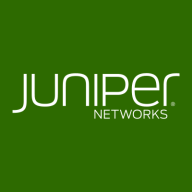

Dell PowerEdge Rack Servers and Juniper QFX Series Switches both compete in the enterprise IT solutions category. Dell PowerEdge shows strength in reliability and ease of hardware upgrades, whereas Juniper QFX shines in network flexibility and scalability.
Features: Dell PowerEdge Rack Servers are noted for scalability, remote management through iDRAC, and reliability. Strong warranty service adds to its appeal, particularly for small and large businesses. In contrast, Juniper QFX Series Switches offer flexibility in high-density environments, with standout features like EVPN-VXLAN for enhanced network scalability and flexibility.
Room for Improvement: Users of Dell PowerEdge suggest enhancements in performance, energy efficiency, and centralized management interfaces. An expansion of virtual view features and better support for HCI are desired. For Juniper QFX Series Switches, GUI enhancements, streamlined deployment processes, and storage-specific connectivity improvements are areas for development.
Ease of Deployment and Customer Service: Dell PowerEdge Rack Servers excel in versatile deployment, supporting both private and hybrid cloud environments. Despite some language-related support challenges, customer service receives positive ratings. Juniper QFX Series Switches focus on strong local service, but deployment difficulties and a steep learning curve for new users affect ease of use.
Pricing and ROI: Dell PowerEdge is cost-effective with competitive pricing against HPE, yielding solid ROI through reduced operational costs. Meanwhile, Juniper QFX is considered more expensive compared to Cisco and Fortinet, but still achieves ROI in large enterprise networks due to its high functionality.
By not having to worry about it, I would estimate we save two to four hours a week, depending on what's happening, such as if we need to spin up a new server, which would contribute to more time if done the old way.
In my immediate case for antenna analysis, Dell PowerEdge Rack Servers offer a reduction from days of computing to half a day or hours.
The value of uptime to us is critical.
The normal ROI customers work with is five years unless there is a major change in technology.
It has always been scheduled maintenance, which says a lot for a production environment, as we haven't had to call in a trouble ticket for the actual hardware during its entire run.
Typically, the contacts we have on-site are very knowledgeable, they come in within a day and usually have it fixed and taken care of if there are issues.
When we had a power supply failure out of the box, we called support, and they delivered the replacement within four hours as promised.
Sometimes parts are not available in stock, then you have to wait for replacement time.
The scalability of Dell PowerEdge Rack Servers is excellent.
Any outages or blackouts are limited to particular servers, not affecting the whole chassis or enclosures.
We bought our product with scaling involved, and we've been scaling it up anytime we've needed more storage.
When building a fabric, you can add multiple leaf switches and multiple spine switches if required.
Over four years, we've had less than 1 percent downtime.
There is a feature to update the server while it is running, so there is no need to restart.
We have truly not had any downtime on the infrastructure at all.
Juniper has better performance than any other networking product as far as performance is concerned in the router area.
We need to know about any upcoming updates so that we can plan accordingly.
The beneficial aspect of that feature was that we could skip the PowerStore and just have the Dell PowerEdge Rack Servers alone, as they also served as storage, which helped us save money.
This forces you to go up to a larger server to get the desired processor, which increases the cost.
My personal opinion is that if anyone wants to work with a Layer 3 fabric in a data center, they should choose Juniper because working with ACI and APIC is very complex in the Cisco part.
They have been stable and running for years without performance downtime or significant disc failures.
Some customers find it cheaper due to contractual agreements, while others find it expensive, especially when scaling up.
The software associated with servers, like VMware subscription licenses, drives costs.
We are a number one, tier-one partner of Juniper. Therefore, we normally get better discounts than with Cisco because we don't have the level one partnership with Cisco.
They keep running for at least five to seven years without any issues.
With PowerEdge Servers, I don't need a one-to-one ratio redundancy, which leads to about eighty percent downtime reduction.
One of the valuable features is Active Directory, which helps in managing the network.
They are easy to use and flexible to deploy in any kind of environment.


Dell PowerEdge Rack Servers are designed to optimize performance and efficiency in a data center environment, supporting various applications. Dell stands as the leading vendor in accelerated servers for AI, commanding a 33.8% revenue share. Based on user reviews, Dell PowerEdge Rack Servers supporting tasks from basic web hosting to more demanding applications like data analytics and virtualization. They are engineered to offer high performance, reliability, and scalability. With a focus on automation and integrated security, these servers simplify operations and protect against threats, making them a smart choice for businesses of all sizes.
Dell PowerEdge Rack Servers are a robust, secure, and scalable solution that can meet the diverse needs of businesses, backed by comprehensive support. Benefits to look for in reviews include performance, reliability, scalability, and customer support.
Dell PowerEdge Rack Servers key features include:
In terms of implementation, Dell PowerEdge Rack Servers are used across various industries, from small businesses to large enterprises. They serve as the foundation for IT infrastructure, powering critical applications in healthcare, finance, education, and more. The adaptability of these servers means they can be tailored to specific industry needs, from handling large datasets in research institutions to supporting high-transaction databases in financial services.
QFX Series Switches deliver industry-leading throughput and scalability, an extensive routing stack, the open programmability of the Junos OS, and a broad set of EVPN-VXLAN and IP fabric capabilities. With QFX, you’ll find premier solutions for data center spine-and-leaf, campus distribution, core, and data center gateway and interconnect switching.
Rethink data center operations and fabric management with turnkey Juniper Apstra software in your QFX Series environment. You can automate the entire network lifecycle to simplify design and deployment and provide closed-loop assurance. With Apstra, customers have achieved 90% faster time to deployment, 70% faster time to resolution, and 83% OpEx reduction.
We monitor all Data Center Networking reviews to prevent fraudulent reviews and keep review quality high. We do not post reviews by company employees or direct competitors. We validate each review for authenticity via cross-reference with LinkedIn, and personal follow-up with the reviewer when necessary.